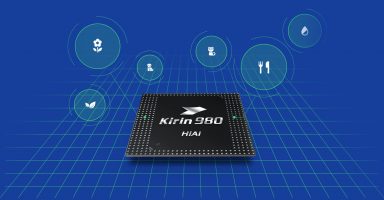Huawei has launched its latest system-on-chip Kirin 980 at the IFA 2018, Berlin. The chip is expected to power the company’s upcoming Mate 20 series and Magic 2 to smartphone as suggested by the CEO Richard Yu during the launch event.
While the new chipset has a lot to offer as company has promised, its prominent factor is the TSMC’s 7nm manufacturing process that is industries first. Compared to it, the competition has yet reached the 10nm process. Previous chips including Kirin 970 used the CPU cores that were then-currently in use by the competition but its availability in Q4 of the year makes it less impressive as the competitors brought even newest chips to the industry sooner the next year. Qualcomm’s latest Snapdragon 845 is using the Cortex-A75 cores.
Huawei is still launching its new chip later in the year but what it did good is that it chose to go further ahead the competition by using the newest processor cores that no one has yet used. Kirin 980 is the first to use the latest ARM cores Cortex-A76.
Kirin 980 in-detail
The new 7nm processor, compared to the previous 10nm process, delivers 20% improved performance and 40% improved power efficiency. The Kirin 980 packs 6.9 billion transistors within a 1cm2 die size that is 1.6 times up compared to Kirin 970.
The new Kirin 980 features an octa-core CPU with the ARM’s new DynamIQ CPU cluster configuration – 4 Cortex-A76 and four Cortex-A55 cores. They are further divided into 2 high-performance and 2 power-efficient cores of A76 while the other 4x A55 cores are low-power. For graphics, Huawei has integrated the Mali-G76 GPU which is also the newest from the vendor. Along with, the chip has the Dual NPU AI, compared to the single in previous generation, promising enhanced power in mobile AI.
Whereas the maximum clock rate of 3GHz as originally announced by ARM when it launched Cortex A76, the pair of high-performance cores in Kirin 980 is clocked at 2.6GHz. So consider the higher clock rate only for the higher thermal design power. These two high-performance cores will server for immediate, intensive workloads.
The chip may operate in more efficient way while providing power saving in two efficiency levels – high-efficiency and ultra-efficiency. The second pair of Cortex A76 cores is clocked only at 1.9GHz while the remaining little four cores of Cortex-A55 are clocked at 1.8GHz. This configuration can lead to the company’s claim of being more power full at its Kirin 980 this time.
While delivering the keynote at IFA 2018 titled Richard Yu, CEO, Huawei Consumer Business Group introduced the revolutionary technology to the world. He said:
“Last year, we showed the world the potential of On-Device AI with the Kirin 970, and this year, we’ve designed an all-round powerhouse that not only features outstanding AI capabilities, but also brings cutting-edge raw performance to consumers. Equipped with all-new CPU, GPU and Dual NPU, the Kirin 980 is the ultimate engine to power next-generation productivity and entertainment applications.”
– said Richard Yu, CEO, Huawei CBG while delivering the keynote at IFA 2018
HiSilicon Kirin Comparison
| Kirin 980 | Kirin 970 | |
|---|---|---|
| Process | TSMC 7nm | TSMC 10nm |
| CPU Octa-core | 2x Cortex-A76 @ 2.6GHz 2x Cortex-A76 @ 1.92GHz 4x Cortex-A55 @ 1.8GHz |
4x Cortex-A73 @ 2.4GHz 4x Cortex A53 @ 1.8GHz |
| GPU | Mali-G76 MP10 @ 720MHz | Mali-G72 MP12 @ 746MHz |
| NPU | 2nd gen – Dual NPU | 1st gen – Single |
| LPDDR4 | 2133MHz | 1866MHz |
| Camera ISP | New Dual ISP +46% speed | Dual ISP 14-bit |
| Modem | Integrated LTE Cat 21 Downlink: 1400 Mbps Uplink: 200 Mbps |
Integrated LTE Cat 18 Downlink: 1200 Mbps Uplink: 150 Mbps |
| Sensor Hub | i8 | i7 |
The Mate 20 Series
Due to having a lot of devices in line to launch, Huawei just pushed out the Mate 20 lite during the event at IFA 2018. However the company only referred to its upcoming high-end lineup in Mate 20 series which will be running on its proprietary chipset Kirin 980 with all those features you have just read above.





